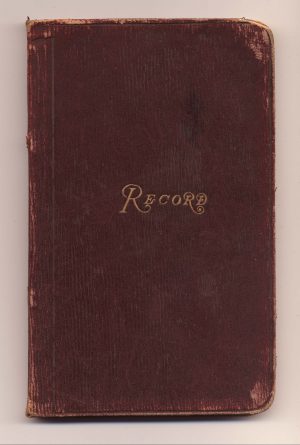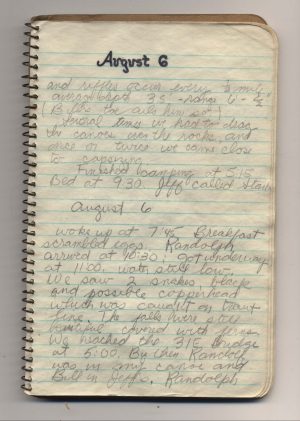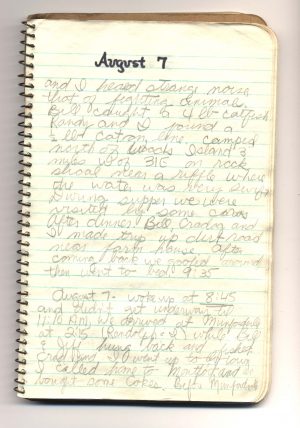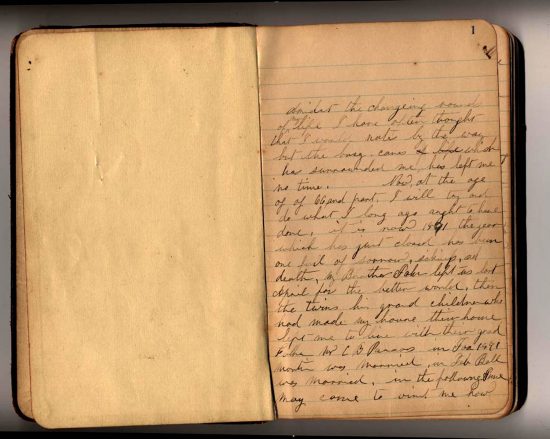On the first day of 1892, my great-great grandmother, Mary Conrad Montfort, opened a thin leather-bound journal and turned to its first page. Dipping her pen into a small bottle of black ink she paused; then she began to write:
“Amidst the changing rounds of my life, I have often thought that I would keep notes by the way, but the busy cares of life which has surrounded me, has left me no time.
“Now at the age of 66 I will now try and do what I long ago ought to have done. It is now 1891. The year which has just closed has been one full of sorrow, sickness and death. My brother John left us last April for the better world, then the twins, his grandchildren who had made my home their home, left me to live with their grandfather Mr. C.B. Panaos.”
Why this particular moment, so late in her life, finally inspired her to record what remained of it, we will never know. But somehow, after more than half a century of experiences, both happy and sad, Mary wanted to preserve them, at least for herself.
She cheerfully took note of the good times as well:
“I came to visit my son Willie. How many times I had wanted to come. Now I am at his home. Have been here 4 months. I spent Christmas and New Years, how Willie has enjoyed it! How delighted the little ones were with their presents…”
 Among the “little ones” was my grandfather, Frank Warren Montfort, who was born in Concordia, Kansas in 1882 and died almost 90 years later, in 1969. But on that December morning, he was only nine years old.
Among the “little ones” was my grandfather, Frank Warren Montfort, who was born in Concordia, Kansas in 1882 and died almost 90 years later, in 1969. But on that December morning, he was only nine years old.
For the next five years, Mary Montfort turned frequently to her journal, to record not just the facts and figures of her life, but the joy and pain those events—those memories—caused. She notes the arrival of her grandson:
“Aug 12th. It was May 12 when I last wrote, three months have passed since I came to Burlington. It seems but yesterday that I arrived here. I was with Bell through her confinement. She felt that Mother must be with her in her coming Motherhood and now the looked for little one has come to us and it is a little boy. Bell is a happy mother and the boy is a very fine child. He makes my 16 grandchild.”
Scribbling must be an inherited trait, for I’ve been keeping diaries and journals since I was 12. Most of my entries are mundane and trivial and hardly worth noting. On one of my first solo canoe trips, without “parental supervision,” I still have my pencil-scrawled notes from the experience. I was 14 and already loving my new-found freedom, but I hardly made the most of it—my most profound recollection of that seminal moment was, “After we ate our hot dogs and beans, we goofed around for a while and then we went to bed. But Bill’s toe still ails him so!”
No profundity there. Or so far, really. But I still have such great hopes for the future.
Humans have been recording and documenting their most private thoughts and feelings for centuries. For thousands of years. Why do we do it? What compels us to record not just the happy times but even the most excruciating details?
Perhaps we find a strange comfort in being able to recall the banalities and tragedies of our lives, as well as the triumphant days—those rare times when everything went right.. It keeps those fading moments closer. Why should we pick and choose our “history?” If we want to remember, we need to remember all of it.
Some fool once said that, “Time heals all wounds,” but I’m not sure healing has anything to do with it—Time simply causes (or allows) us to forget. It may the ultimate survival factor in our chemistry. The hard edges of our memories soften, the sting of painful flashbacks subsides. It gets blurry.
So, for better or worse, we journal keepers choose to rebel against Time, we pick at our wounds and we try to pull the breadth of our lives, warts and all, close to our hearts.
Rarely do our journals find a readership beyond their authors. It is the one personal item no one knows what to do with, when we contemplate the world after we’re gone. Who do we bequeath our unbridled thoughts and emotions to? We all have our secrets and few of us want to share them, even from the grave.
what to do with, when we contemplate the world after we’re gone. Who do we bequeath our unbridled thoughts and emotions to? We all have our secrets and few of us want to share them, even from the grave.
Some do, but usually only those who coincidentally become celebrities and the property of the people. Ed Abbey made plans for the publication of his journals, years before he died; he even edited them. He could hardly have known, when he first started scribbling in the 1940s, that his early musings would be of interest to the world. Or maybe he did. Still, in the end, most of us would prefer our journals be buried or burned (the preferred option) with us.
But now, in the 21st Century, the hand-written journal may have seen its better day. Laptop computers, the iPad, even cell phone and the abandonment of handwritten texts of any kind makes the cherished journal an endangered species.
Penmanship alone once offered insights into a person’s character. It’s startling to compare my own flawless cursive letters from 40 years ago to the almost unreadable scrawl I produce now. What does that say about the aging process or are we just in a bigger hurry? I’d guess handwriting experts, who can glance at a note and create a psychological profile of the scribbler are becoming endangered as well. Who sends handwritten death threats anymore? They just go to Kinkos, choose a font and ask for copies. The clerks won’t notice the content; they’re all multi-tasking on their cell phones anyway.
And what of the physical nature of the journal itself? This weathered battered book that we’ve loyally carried with us and shows all the same wear that we’ve endured along the way. I think of the journal as my empathetic traveling companion…its bruises and tears are mine as well. Its mementoes a part of my soul…
Here is the aspen leaf from 1973 that I gathered in the La Sal Mountains…here is the ketchup stain from a leaky burger at the Westerner Grill in 1986. And here are the desiccated remains of a maddening little bush fly, slammed and crushed between two pages of my 1998 Aussie journal, in that favorite camp spot of mine in the pines along the Ludlow-Tuart highway. Still there in repose, still properly squashed after all these years. I’d been after that little devil for hours. He is as close to a big game trophy as I’ll ever get.
Today, the iPad is a poor substitute for a mosquito bat and hardly an appropriate repository for a 37 year old aspen leaf. A ketchup stain might very well short out its circuits. Still the world seems to be moving away from anything that doesn’t run on a lithium battery. And from keeping those innermost thoughts anything but personal (facebook!).
 I think about my great-great grandmother and wonder if she’d resent my re-telling just a small part of her story. Mary Montfort kept writing of her life and her family for another five years. In 1896, the Montforts suffered another hard blow when her grandson caught pneumonia and died..
I think about my great-great grandmother and wonder if she’d resent my re-telling just a small part of her story. Mary Montfort kept writing of her life and her family for another five years. In 1896, the Montforts suffered another hard blow when her grandson caught pneumonia and died..
“…for 13 days he fought for life but he had to go and the little bright life so lovely had to go. I hardly know how to write it, or about it. We have all been so sad, so sorrowful. So much as been crowded into the last two weeks., suffering hope, then fear without hope, then all was given up to death and our little boy so lovely. The joy of the household. A great sorrow has filled this place.”
Her entries in the journal became infrequent and on May 4, 1896, they abruptly stopped. Why Mary put the pen down for good, we can only speculate but her last tragedy may have been too much. She lived another 18 months and died in the summer of 1898. Her notebook became a family relic though few ever read it. Perhaps it was too painful. But for me, feeling Mary Montfort struggle for words, for comfort and for understanding allows me to keep the memory of a distant relative alive, more than a century after she left us.
At the end of the day, her life wasn’t all that different from our own, as we find our own crises and trials in 2017. What matters is that we remember and that we care.
Jim Stiles is the Founder and Co-Publisher of the Canyon Country Zephyr.










Hands? Mine are too tired. Good thing I have this phone to see me through.
Valerie’s journal is almost entirely drawings. She is not likely to download to Flicker or Klicker or Twitter.
Hand and eye. What we are or will be.
I have an old steamer trunk overflowing with all the journals I’ve kept — thousands and thousands of pages — since the age of 11. (My inaugural journal entry read: “Take R.M. — so pretty, so perfect. My one consolation is that I write better compositions than she does.”) I don’t journal as obsessively any more, being too busy writing essays and stories, but I wonder if the art of journalling is really dead. I work in a large-format bookstore, and we have an enormous section of journals, and they sell like crazy, especially the expensive ones. Maybe no one’s journalling, but they all like the IDEA of journalling. Or maybe they’re just using them as colouring books.
I don’t have a steamer trunk full of journals, but mine fill several bookcases, all handwritten.
They begin on a yellow legal pad I scratched on on a cross country trip in 1979 when my first wife–lone gone from
my life, and vicey-versa–and I went on a cross country trip in a ’76 VW SuperBeetle in a vain attempt to save our sinking marriage.
Over the years they migrated to a 8 1/2 x 11 sketchbooks.
I’ve mostly journalled daily for years, starting my day with the date and time I hit the page and the weather if it’s light enough to see it. At least if I get distracted with my morning reading, I can say I rote something. I go through one of those sketchbook about every 6 months, like you Melinda, I’ve written a book . or two a year this way.
So , no, I don’t think it’s a dead cause, at least not from where I sit. Besides drinking beer and being a kind to others as I can, it migh be the best habit I have.
My 12 year old nephew, seeing me do it a time or two, has been journaling for a couple of months now. We’ll see if he keeps it up. He is proud that he’s the only one of his peers who even try.
There’s hope.
Thanks for the article Jim.
Best,
Deryle Perryman
Albuquerque
In more than one comment drawings are mentioned. Believe me, drawn journals, especially those done daily……they count too.
I draw often and on a regular schedule. I have noticed that several of our models keep journals. I have seen that they almost all include drawings, Tracy’s are all drawings.
I believe there is as much personal information conveyed in a daily drawing as there is in a daily written journal. It is possible that they are not the same and should not be thusly compared. I doubt this.
What is important here is that we are much more like one another than we are different. Journaling establishes a habit of daily introspection. Look closer at yourself, behave better when in company. Not a bad idea at all.
The Canyon Country Zephyr is a great name…….but people, this man speaks to the world. All of us.
Thanks for clinging.
Geo